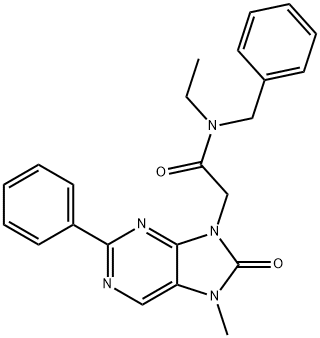
N/A
中文名称:
N/A
中文同义词:
英文名称:
AC-5216
英文同义词:
EMapunil;XBD-173;N-Benzyl-N-ethyl-2-(7-Methyl-8-oxo-2-phenyl-7,8-dihydro-9H-purin-9-yl)acetaMide;9H-Purine-9-acetaMide,N-ethyl-7,8-dihydro-7-Methyl-8-oxo-2-phenyl-N-(phenylMethyl)-;AC 5216 (Emapunil);N-Ethyl-7,8-dihydro-7-methyl-8-oxo-2-phenyl-N-(phenylmethyl)-9H-purine-9-acetamide;Emapunil(AC-5216);AC-5216
CAS号:
226954-04-7
分子式:
C23H23N5O2
分子量:
401.46
EINECS号:
相关类别:
小分子抑制剂;小分子抑制剂,天然产物;活性分子;Inhibitors
Mol文件:
226954-04-7.mol
储存条件
2-8°C
形态
powder
颜色
white to beige
生物活性
Emapunil (AC-5216, 18 kiloDalton Translocator Protein, XBD173)是一种新型的 mitochondrial benzodiazepine receptor/translocator protein (MBR/TSPO) 配体。Emapunil(AC-5216) 对大鼠全脑制备的 MBRs 具有高亲和力,Ki值为0.297 nM,在大鼠神经胶质瘤细胞和人神经胶质瘤细胞上的IC50值分别为 3.04 nM和 2.73 nM。
靶点
Target Value
mMBR(Brain)
(Cell-free assay) 0.297 nM(Ki)
MBR
(human glioma cells-based assay) 2.73 nM
MBR
(rat glioma cells-based assay) 3.04 nM
Target
Value
mMBR(Brain)
(Cell-free assay)
0.297 nM(Ki)
MBR
(human glioma cells-based assay)
2.73 nM
MBR
(rat glioma cells-based assay)
3.04 nM
体内研究
Emapunil (AC-5216, 0.1-3, 0.003-0.01 and 0.01-0.3 mg/kg, p.o.) produces anti-anxiety effects in the Vogel-type conflict test in rats, and in the light/dark box and social interaction tests in mice.
Emapunil (AC-5216, 3-30 mg/kg, p.o.) reduces the immobility time, and this effect was blocked by PK11195.
Emapunil (AC-5216, 1-100 mg/kg, p.o.) produces no distinct change in the rat electroencephalogram.
Emapunil (AC-5216, 0.3 and 1 mg/kg, i.g.) causes significant suppression of the enhanced anxiety and contextual fear induced in post-TDS rats.
Emapunil (AC-5216, 0.3 and 1 mg/kg, i.g.) alleviates the enhanced anxiety and fear response in a time-dependent sensitization (TDS) procedure, a rat PTSD animal model.
Emapunil (AC-5216, 0.3 and 1 mg/kg, i.g.) reverses the increased plasma glucose (PG) and decreased insulin (INS) in HFD-STZ rats.
Animal Model: Rats.
Dosage: 0.1-3 mg/kg.
Administration: P.O..
Result: Significantly increased the number of shocks that rats received.
Significantly increased the time spent in the light compartment but only slightly increased that time at 0.03 mg/kg, p.o. (P<0.1).
Animal Model:
Rats.
Dosage:
0.1-3 mg/kg.
Administration:
P.O..
Result:
Significantly increased the number of shocks that rats received.
Significantly increased the time spent in the light compartment but only slightly increased that time at 0.03 mg/kg, p.o. (P<0.1).








